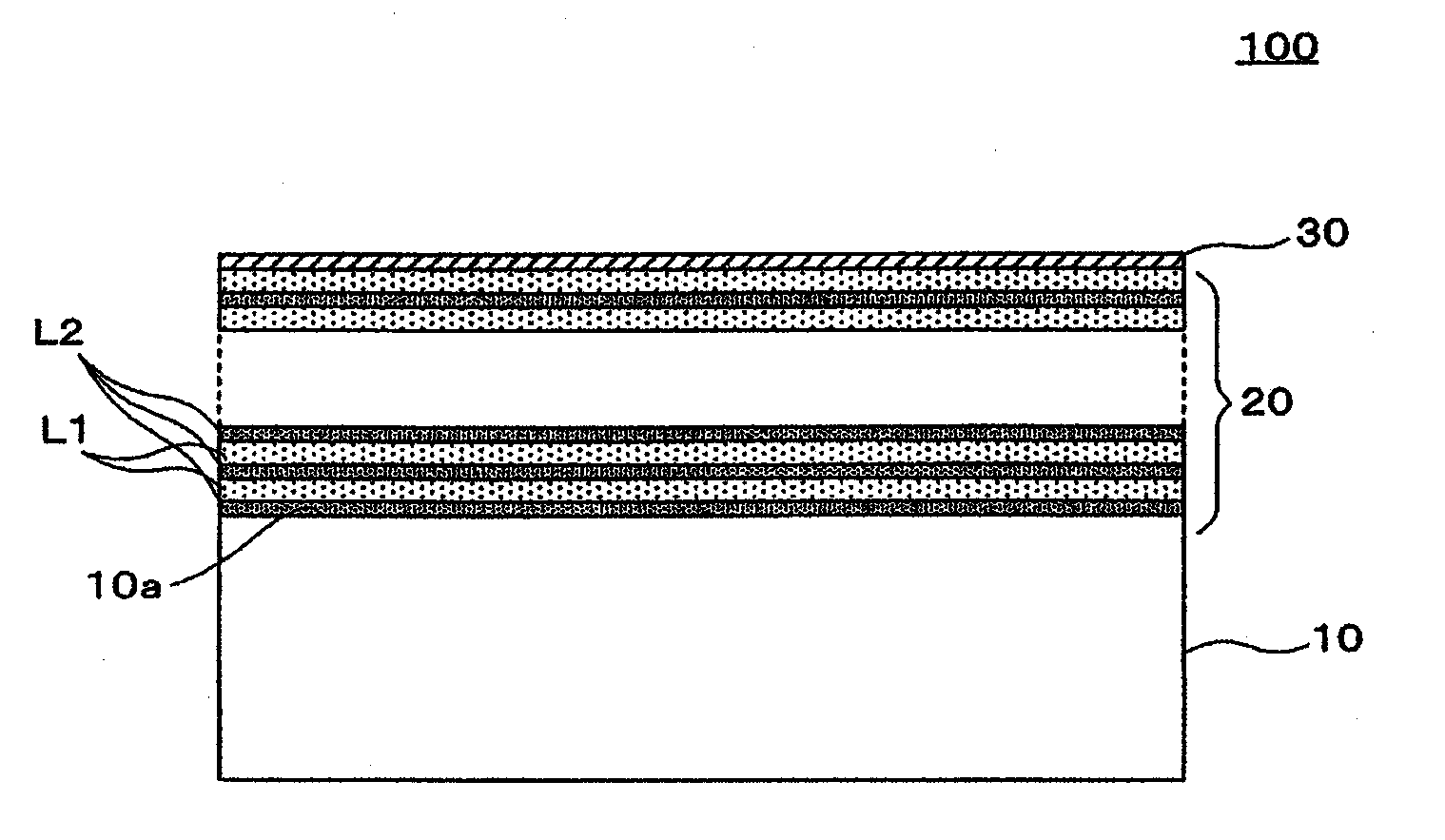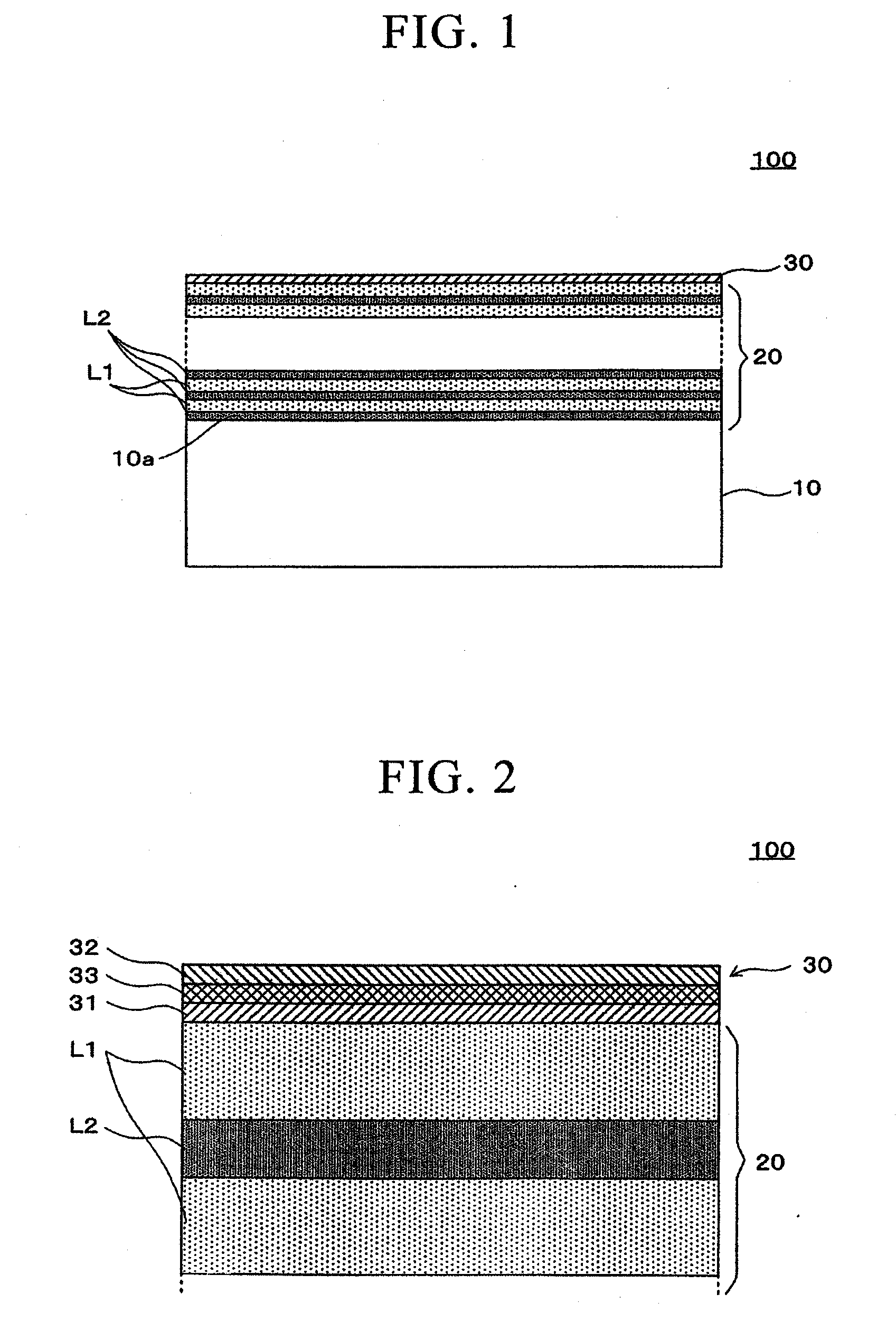Optical element, exposure apparatus using this, and device manufacturing method
a technology of exposure apparatus and optical element, which is applied in the direction of photomechanical apparatus, instruments, printing, etc., can solve the problems of degrading the reaction reducing the imaging properties of the projection optical system, and reducing the life of the optical element, so as to maintain the reflective properties of the optical element over a long period, suppress the non-exposure light, and reduce the non-exposure light
- Summary
- Abstract
- Description
- Claims
- Application Information
AI Technical Summary
Benefits of technology
Problems solved by technology
Method used
Image
Examples
first embodiment
[0025]FIG. 1 is a cross-sectional view which shows the structure of the optical element pertaining to a first embodiment. The optical element 100 of the present embodiment is, for example, a flat mirror and has a substrate 10 that supports a multilayer film structure, a multilayer film 20 for reflection, and a protective layer 30 that constitutes the surface layer.
[0026]The underlying substrate 10 is formed, for example, by machining synthetic quartz glass or low-expansion glass, and its top face 10a is polished to a mirror surface of prescribed accuracy. The top face 10a may be made into a plane as illustrated in the drawing, or it may be made concave, convex, multifaceted or some other shape (not illustrated in the drawing) according to the application of the optical element 100.
[0027]The multilayer film 20 that is above is a thin film of from several layers to several hundred layers, and is formed by alternately laminating two types of materials having different refractive indice...
first example
[0040]Below, a description is given of a specific working example of the optical element 100 pertaining to the first embodiment. “ULE”® (Ultra-Low Expansion), which is a low thermal expansion glass manufactured by Corning International Co., was used as the material of the substrate 10. One may also use other low thermal expansion glass instead of ULE, such as “Zerodur”® manufactured by Schott Co., and “CLEARCERAM-Z”® manufactured by Ohara Co. In order to prevent a reduction in reflectance due to surface roughness of the substrate 10, the surface of the substrate 10 is polished to a surface roughness of 0.3 nm RMS or less.
[0041]A multilayer film 20 of Mo / Si type was then formed by the sputtering method on the aforementioned substrate 10. In this case, the thin-film layer L1 was a Si layer with a small difference relative to a refractive index of 1, and its thickness was set to 4.6 nm. The thin-film layer L2 was a Mo layer with a large difference relative to a refractive index of 1, a...
second example
[0046]Below, a description is given of a specific second example of the optical element 100 pertaining to the first embodiment. It should be noted that the optical element 100 in the second example is a modified example of the first example. Substantial descriptions of elements that are identical to the elements of the first example are omitted.
[0047]In the second example, the protective layer 30 is provided on top of the Si layer (i.e., the topmost Si thin film layer L1) that is the topmost layer of the Mo / Si multilayer film 20 and that has a thickness of 3.2 nm. In the protective layer 30, the interfacial-side layer 31 consisting of SiO and having a thickness of 3.2 nm is formed, the intermediate layer 33 consisting of SiO1.5 and having a thickness of 3.2 nm is formed, and the surface-side layer 32 consisting of SiO2 and having a thickness of 3.2 nm is formed.
[0048]FIGS. 4A and 4B show reflection characteristics of the optical element 100 in the second example. In FIG. 4A, the sol...
PUM
| Property | Measurement | Unit |
|---|---|---|
| wavelengths | aaaaa | aaaaa |
| size | aaaaa | aaaaa |
| refractive index | aaaaa | aaaaa |
Abstract
Description
Claims
Application Information
 Login to View More
Login to View More - R&D
- Intellectual Property
- Life Sciences
- Materials
- Tech Scout
- Unparalleled Data Quality
- Higher Quality Content
- 60% Fewer Hallucinations
Browse by: Latest US Patents, China's latest patents, Technical Efficacy Thesaurus, Application Domain, Technology Topic, Popular Technical Reports.
© 2025 PatSnap. All rights reserved.Legal|Privacy policy|Modern Slavery Act Transparency Statement|Sitemap|About US| Contact US: help@patsnap.com



